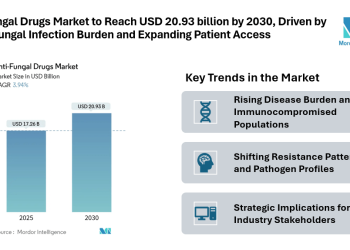Introduction
The antimicrobial resistance surveillance market is valued at USD 6.24 billion in 2025 and is forecasted to reach USD 8.23 billion by 2030, progressing at a 5.69% CAGR during the period, rising data-sharing initiatives, and broader adoption of connected laboratory workflows. As policymakers and health systems increase investment in surveillance programs, the antimicrobial resistance surveillance market size continues to expand across regions with improved readiness, expanded screening programs, and wider integration of genomic tools.
Growing pathogen burden, the need for stronger outbreak response frameworks, and the shift toward standardized reporting models all contribute to the antimicrobial resistance surveillance market growth. Public health bodies, hospitals, and reference laboratories are increasingly relying on coordinated surveillance platforms to track resistance patterns, share findings, and support early intervention.
Key Trends
Strengthening Laboratory Coordination and Reporting
A central trend shaping antimicrobial resistance surveillance market analysis is the rising focus on linking hospital labs, regional centers, and national surveillance bodies through unified platforms. These networks help streamline data transfer, support consistent reporting practices, and enable faster review of pathogen trends. As countries invest in central repositories and harmonized reporting tools, labs gain clearer visibility into emerging resistance threats.
Growing Use of Genomic and Molecular Surveillance
Another key trend is the increasing use of genomic-based approaches to better understand resistance spread. Surveillance networks are gradually integrating sequencing-supported workflows that allow health authorities to map strains, examine transmission clusters, and detect resistance markers more accurately. This trend supports the antimicrobial resistance surveillance market share as molecular tools become more accessible to a wider set of labs.
Expansion of Public–Private Partnerships
Collaboration between governments, research bodies, and solution providers continues to grow, enabling surveillance programs to expand beyond major cities and into secondary health systems. These partnerships encourage wider participation in surveillance studies, improve training for lab personnel, and promote broader adoption of standardized testing approaches. As partnerships expand, surveillance coverage increases across healthcare systems, helping authorities track resistance more consistently over time.
Increasing Emphasis on Global Data-Sharing Initiatives
International programs that encourage data exchange, harmonized surveillance methods, and coordinated research contribute to one of the most important antimicrobial resistance surveillance market trends. Cross-border collaboration allows countries to compare resistance patterns, identify emerging risks, and share early warnings. As participation in global surveillance initiatives grows, countries gain improved preparedness and stronger disease-control frameworks.
Check out more details and stay updated with the latest industry trends, including the Japanese version for localized insights:
Market Segmentation
By Organism Type
The antimicrobial resistance surveillance market is segmented by organism categories commonly screened across hospitals, clinics, and laboratories. Surveillance systems support detection and reporting for a wide range of pathogens and resistance markers. Key organism groups included in the segmentation are:
By Solution
- Kits
- Systems
- Surveillance Software
- Surveillance Services
By Technology
- Culture-based Methods
- Molecular Diagnostics
- Whole-Genome Sequencing
- AI and Data-Analytics Platforms
- Others
By Application
- Clinical Diagnostics
- Public Health Surveillance
- Antimicrobial Stewardship Programmes
- Pharma & Biotech R&D
- Others
By End-User
- Hospitals and Clinics
- Diagnostic Laboratories
- Other End-Users
By Geography
- North America
- Europe
- South America
- Middle east&Africa
- Asia pacific
Key Players
A range of global and regional organizations support the development of surveillance tools, laboratory systems, and coordinated reporting networks. Solution providers focus on improving data integration, supporting real-time review, and enabling laboratories to meet surveillance requirements more efficiently. Some organizations provide digital platforms, while others supply laboratory equipment, workflow tools, or surveillance technology.
- Pfizer Inc.
- Merck KgaA
- Thermo Fisher Scientific
- Cepheid
- Liofilchem S.r.l.
Conclusion
The antimicrobial resistance surveillance market is entering a period of steady expansion as countries prioritize routine monitoring, outbreak readiness, and unified reporting structures. Surveillance systems are now at the center of public-health planning, helping authorities respond faster to changes in resistance patterns and improve coordination between hospitals, labs, and national programs.
With broader integration of data-sharing tools, growing lab participation, and increased use of molecular analysis methods, the market is set to experience meaningful progress through the forecast period. Health systems are recognizing the value of long-term surveillance, especially as resistance patterns shift across regions.
Industry Related Reports
Microbial Identification Market: The Microbial Identification Market Segments by Products and Services (Instruments, Consumables and More), by Technology (MALDI-TOF, MSPCR & Real-Time and More), by End User (Hospitals & Clinical Laboratories and More), by Application (Clinical Diagnostics, Pharmaceutical Manufacturing QC and More) and Geography (North America and More).
AI In Epidemiology Market: The AI in Epidemiology Market is Segmented by Deployment (Cloud-Based and Web-Based/On-Prem), Application (Infection Prediction & Forecasting, and More), End User (Pharmaceutical & Biotechnology Companies, and More), AI Technology (Machine-Learning Algorithms, and More), and Geography (North America, Europe, Asia-Pacific, Middle East & Africa, South America).
Metagenomics Market: The Metagenomics Market is Segmented by Product (Sequencing & Data Analytics Services, and More), Technology (Sequencing-Driven, Function-Driven, and More), Application (Human Health, Environmental Monitoring, and More), End User (Academic, Clinical Diagnostic Laboratories, and More), and Geography (North America, Europe, Asia Pacific, and More).
About Mordor Intelligence:
Mordor Intelligence is a trusted partner for businesses seeking comprehensive and actionable market intelligence. Our global reach, expert team, and tailored solutions empower organizations and individuals to make informed decisions, navigate complex markets, and achieve their strategic goals.
With a team of over 550 domain experts and on-ground specialists spanning 150+ countries, Mordor Intelligence possesses a unique understanding of the global business landscape. This expertise translates into comprehensive syndicated and custom research reports covering a wide spectrum of industries, including aerospace & defense, agriculture, animal nutrition and wellness, automation, automotive, chemicals & materials, consumer goods & services, electronics, energy & power, financial services, food & beverages, healthcare, hospitality & tourism, information & communications technology, investment opportunities, and logistics.
For any inquiries or to access the full report, please contact:
media@mordorintelligence.com
https://www.mordorintelligence.com/













